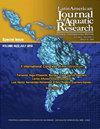海马体浮游阶段的转运条件[j] . Ginsburg, 1933(鱼骨目:海马科)
IF 0.8
4区 农林科学
Q3 FISHERIES
Latin American Journal of Aquatic Research
Pub Date : 2023-07-02
DOI:10.3856/vol51-issue3-fulltext-2996
引用次数: 0
摘要
每年有成千上万的海马作为海洋观赏物种被交易。虽然已经解决了成年海马的包装方法,但没有关于幼年海马运输的信息。因此,本研究旨在评估新生海马的包装和运输的可能性。将三批新生长嘴海马海马雷迪分三次从本文章由计算机程序翻译,如有差异,请以英文原文为准。
Transport conditions in the planktonic phase for seahorses Hippocampus reidi Ginsburg, 1933 (Teleostei: Syngnathidae)
Thousands of seahorses are traded every year as marine ornamental species. Although packing methods for live adult seahorses have already been addressed, there is no information on the transportation of juvenile seahorses. Thus, this study aimed to evaluate the possibility of packing and transportation for newly-birthed seahorses. Three batches of newborn long-snout seahorses Hippocampus reidi were transported in three independent events from Ubatuba, north coast of São Paulo, to the city of São Paulo, covering 248 km in each trip, with an average duration of 3.5 h. A mean of 350 offspring of one day old was distributed in 1 L containers with round borders at equal densities, provided with constant aeration by portable pumps. Aeration was kept so that large bubbles would create an ascending flow keeping juveniles in suspension throughout transportation. Values of survival achieved in this study, even after 10 days post-transportation, were surprisingly high, reaching over 70%. No significant shift in water temperature, pH, or salinity was observed for any transportation events. For oxygen levels, although portable pumps were used, a drop of around 15% in DO level was recorded. In view of the trending ornamental fish market, considering the limited swimming capacity of newly born seahorses and that a great number of marine fish undergo a planktonic phase, this study provides important directions to a better understanding on seahorse transportation and yet, directions for the design of new transport methodology for an efficient shipping protocol for other species.
求助全文
通过发布文献求助,成功后即可免费获取论文全文。
去求助
来源期刊

Latin American Journal of Aquatic Research
FISHERIES-MARINE & FRESHWATER BIOLOGY
CiteScore
1.70
自引率
10.00%
发文量
44
审稿时长
4-8 weeks
期刊介绍:
Latin American Journal of Aquatic Research- LAJAR is the continuation of the journal Investigaciones Marinas (1970-2007) and is published since 2008 by the Escuela de Ciencias del Mar, Facultad de Ciencias del Mar y Geografía of the Pontificia Universidad Católica de Valparaíso. LAJAR is an “Open Access” journal that publishes in English language, original research articles, reviews and short communications on aquatic science, which contain the results of research conducted in aquaculture or in oceanic and coastal marine waters of Latin America.
The following topics are considered: Physical Oceanography, Chemical Oceanography, Marine Biogeochemistry, Marine Pollution and Toxicology, Marine Geology and Geophysics, Biological Oceanography, Fisheries and Aquaculture.
 求助内容:
求助内容: 应助结果提醒方式:
应助结果提醒方式:


